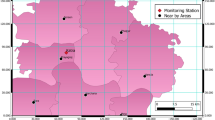Abstract
Deepawali is one of the main festivals for Hindu religion which falls in the period October–November every year with great fireworks display. In this study, we investigated the levels of water soluble ions and heavy metals—during the fireworks festival in Rajnandgaon, Central India. The chemical compositions and noise level distributions are reported from the sampling site. First time during Deepawali, air quality was studied in this area, The Aerosol samples of PM10 (particle aerodynamic diameter <10 μm) are collected in October 24–28, 2011. Aims of the present studies are (1) To describe the particulate concentrations and associated chemical species during Deepawali festival, (2) To recognize the noise level in Deepawali festival. For study, the samples were collected in glass fiber filter paper and analyzed for the major water soluble ions F−, Cl−, NO3 −, SO4 2−, Na2+, NH4 +, K+, Ca2+, and Mg2+ employing ion chromatograph. Concentration of heavy metals was analyzed by ICP-MS and was observed to occur in order Fe > Zn > Pb > Ni > Cr > Cd. The result revels that all concentration are above the permissible limit fixed by CPCB, USPEA, and WHO standard. It is concluded that the burning of fireworks during Deepawali festival was the main source of heavy metals and ion.






Similar content being viewed by others
References
Ambade B, Ghosh S (2012) Toxicity of fluorides in the environment (ISBN: 978-3-8465-2902-7). Lap-Lambert Academic Publishing, Germany
Attri AK, Kumar U, Jain VK (2001) Formation of ozone by fireworks. Nature 411:1015
Avino P, Casciardi S, Fanizza C, Manigrasso M (2011) Deep investigation of ultrafine particles in urban air. Aerosol Air Qual Res 11:654–663
Babu SS, Moorthy KK (2001) Anthropogenic impact on aerosol black carbon mass concentration at a tropical coastal station: a case study. Curr Sci 81:1208–1214
Bull MJ, Agran P, Gardner HG, Laraque D, Pollack SH, Smith GA (2001) Committee on injury and poison prevention fireworks-related injuries to children. Am Acad Pediatr 108:190–201
CPCB (2007) Annual report: 2006–2007. Central pollution control board: New Delhi, India. http://www.cpcp.nic.in/National_Ambient_Air_Quality_Satndards.php
Dockery D, Pope C, Xu X, Spengler J, Ware J, Fay M, Ferris B, Speizer F (1993) An association between air pollution and mortality in six U. S. cities. N Engl J Med 329:1753–1759
Drewnick F, Hings SS, Curtius J, Eerdekens G, Williams J (2006) Measurement of fine particulate and gas-phase species during the New Year’s fireworks 2005 in Mainz, Germany. Atmos Environ 40:4316–4327
Fleischer O, Wichmann H, Lorenz W (1999) Release of polychlorinated dibenzo-p-dioxins and dibenzofurans by setting off fireworks. Chemosphere 39:925–932
Furuuchi M, Choosong T, Hata M, Otani Y, Tekasakul P, Takizawa M, Nagura M (2010) Development of a personal sampler for evaluating exposure to ultrafine particles. Aerosol Air Qual Res 10:30–37
Geiss O, Barrero-Moreno J, Tirendi S, Kotzias D (2010) Exposure to particulate matter in vehicle cabins of private cars. Aerosol Air Qual Res 10:581–588
Giri B, Patel KS, Jaiswal NK, Sharma S, Ambade B, Wang W, Simonich SLM, Simoneit BRT (2013) Composition and sources of organic tracers in aerosol particles of industrial central India. Atmos Res 120–121:312–324
Gligorovski S, Van Elteren JT, Grgic I (2008) A multi-element mapping approach for size-segregated atmospheric Particles using laser ablation ICP-MS combined with image analysis. Sci Total Environ 47:594–602
Huang SL, Hsu MK, Chan CC (2003) Effects of submicrometer particle compositions on cytokine production and lipid peroxidation of human bronchial epithelial cells. Environ Health Perspect 111:478–482
Kim KH, Sekiguchi K, Kudo S, Sakamoto K (2011) Characteristics of atmospheric elemental carbon (Char and Soot) in ultrafine and fine particles in a roadside environment. Aerosol Air Qual Res 11:1–12
Kulshrestha UC, Rao TN, Azhaguvel S, Kulshrestha MJ (2004) Emissions and accumulation of metals in the atmosphere due to crackers and sparkles during Diwali festival in India. Atmos Environ 38:4421–4425
Lin CC, Chen SJ, Huang KL, Hwang WI, Chien GPC, Lin WY (2005) Characteristics of metals in nano/ultrafine/fine/coarse particles collected beside a heavily traffic road. Environ Sci Technol 39:8113–8122
Liu DY, Rutherford D, Kinsey M, Prather KA (1997) Real-time monitoring of pyrotechnically derived aerosol particles in the atmosphere. Anal Chem 69:1808–1814
Maynard AD, Kuempel ED (2005) Airborne nanostructured particles and occupational health. J Nanopart Res 7:587–614
Pawar CT, Joshi MV (2005) Urban development and sound level in Ichalkaranji city, Maharashtra. India J Environ Ecoplan 10(1):177–181
Peters A, Dockery DW, Muller JE, Mittlemean MA (2001) Increased particulate air pollution and the triggering of myocardial infarction. Circulation 103:2810–2815
Ravindra K, Mor S, Kaushik CP (2003) Short-term variation in air quality associated with firework events: a case study. J Environ Monit 5:260–264
Tang SK, Tong KK (2004) Estimating traffic noise for inclined roads with freely flowing traffic. App Acoust 65:171–181
Tiwari S, Chata DM, Srivastava MK, Safai PD, Bisht DS (2012) Statistical evaluation of PM10 and distribution of PM1, PM2.5 and PM10 in ambient air due to extreme fireworks episodes (Deepawali festivals) in megacity Delhi. Nat Hazards 61:521–531
USEPA (2009) United States environment protection agency national ambient air quality standards. Government notification, United States, 17 October 2006
Veranth JM, Reilly CA, Veranth MM, Moss TA, Langelier CR, Lanza DL (2004) Inflammatory cytokines and cell death in BEAS-2B lung cells treated with soil dust, lipopolysaccharide, and surface-modified particles. Toxicol Sci. 82:88–96
Wang Y, Zhuan G, Xu C, An Z (2007) The air pollution caused by the burning of fireworks during the lantern festival in Beijing. Atmos Environ 41:417–431
WHO (2005) Air quality guidelines global update published by World Health Organization. Available at http://www.euro.who.int/document/e87950.pdf
Acknowledgments
The authors are grateful to Prof. R. B. Kodali, Director NIT Jamshedpur for providing lab facilities.
Author information
Authors and Affiliations
Corresponding author
Rights and permissions
About this article
Cite this article
Ambade, B., Ghosh, S. Characterization of PM10 in the ambient air during Deepawali festival of Rajnandgaon district, India. Nat Hazards 69, 589–598 (2013). https://doi.org/10.1007/s11069-013-0725-8
Received:
Accepted:
Published:
Issue Date:
DOI: https://doi.org/10.1007/s11069-013-0725-8




